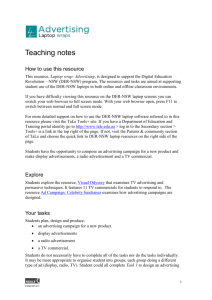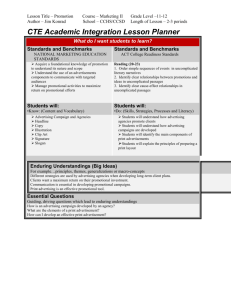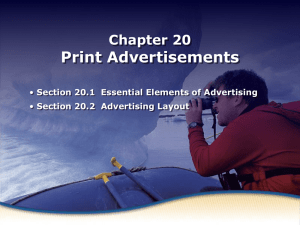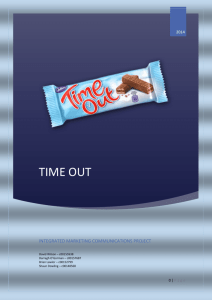Ch. 20 Print Advertisements
advertisement
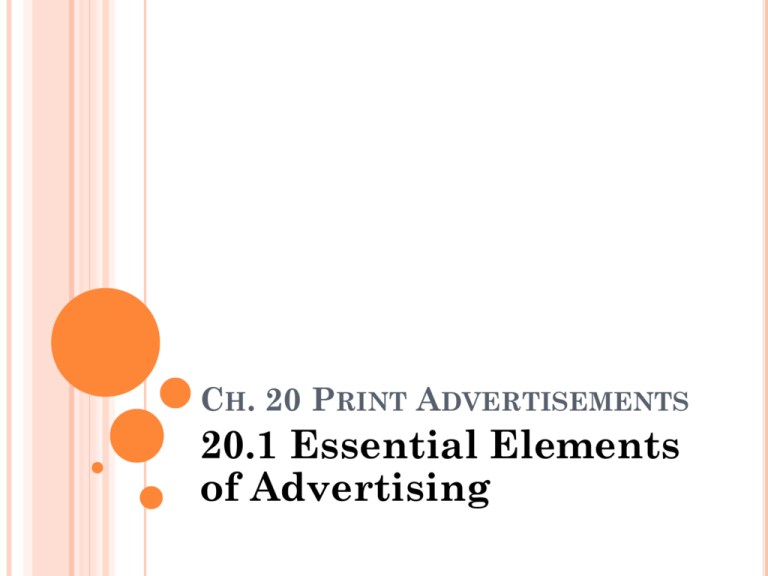
CH. 20 PRINT ADVERTISEMENTS 20.1 Essential Elements of Advertising PRELIM ASSIGNMENT—WORKING FOR AN AD AGENCY Without opening your text, use the half sheet of paper to develop & create a graphic sketch of a Magazine Print Advertisement for a favorite product of yours You may select an item that currently has a print advertising campaign but make your advertisement is an original work (do not try and sketch an exact advertisement out of a magazine) As you are developing your ad think of all the similarities you find in print advertisements and try to include all necessary elements 20_1 ESSENTIAL ELEMENTS OF ADVERTISING Successful advertising campaigns include essential elements to help sell products and services. I. ADVERTISING CAMPAIGN Advertising campaign A group of advertisements, commercials, and related promotional materials and activities that are designed as a part or a coordinated advertising plan to meet the specific goals of a company STEPS TO PLANNING AN ADVERTISING CAMPAIGN 1. 2. 3. 4. 5. 6. Identify the target audience Determine objectives Establish the budget Develop the message Select the media Evaluate the campaign A. ADVERTISING AGENCIES Advertising agencies Independent businesses that specialize in developing ad campaigns and crafting the ads for clients Limited-service agencies – specialize in one aspect of the campaign (ex. creative services, media planning, buying, etc.) B. NEW MODELS FOR ADVERTISING AGENCIES Creative boutique – develops the message and copy but outsources the design & production Project team agencies – provide copywriting, creative execution, & media placement Virtual agencies – one person organizes many experienced freelancers II. DEVELOPING PRINT ADVERTISEMENTS A. HEADLINE Headline The phrase or sentence that captures the readers’ attention, arouses their interest, and entices them to read the rest of the ad WRITING EFFECTIVE HEADLINES Must identify a benefit of the product or service. promise asking a question posing a challenge using a testimonial People cannot process more than seven words at one time. B. COPY Copy The selling message of a written advertisement Should be based on the objectives for an advertising campaign: introduce new product build an image attract new customers answer inquiries generate sales TIPS FOR A SUCCESSFUL COPY Copy should be written in a personal/friendly manner Keep it simple and direct Should appeal to the senses Should tell the who, what, when, where, why, and how of your product Add desire and urgency Should provide a personal call to action C. ILLUSTRATION Illustration The photograph, drawing, or other graphic elements used in an advertisement 1. Sources for Illustrations Clip art Images, stock drawings, and photographs used in print advertisements D. SIGNATURE Signature The distinctive identification for a business; also known as a logotype or logo 1. SLOGAN Slogan A catchy phrase or words that identify a product or company Alliteration uses repeating initial consonant sounds A paradox is a seeming contradiction that could be true Rhyme uses rhyming words or phrases A pun is a humorous use of a word that suggests two or more of its meanings or the meaning of another word similar in sound A play on words cleverly uses words to mean something else


